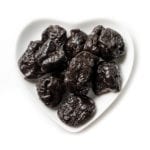Written by Greg Arnold, DC, CSCS. In a study of 48 women between the ages of 65 and 79 with osteopenia, significant improvements in bone density were seen in the dried plum group versus the control group.
 In the United States alone, nearly half of all women over the age of 50 years will suffer a fracture due to osteoporosis, resulting in more than 1.5 million fractures per year, including painful and often debilitating hip fractures (1). Osteoporosis in the American elderly population cost our healthcare system $22 billion in 2008 (2) and hip fractures have been shown to increase the risk of death by 20% (3).
In the United States alone, nearly half of all women over the age of 50 years will suffer a fracture due to osteoporosis, resulting in more than 1.5 million fractures per year, including painful and often debilitating hip fractures (1). Osteoporosis in the American elderly population cost our healthcare system $22 billion in 2008 (2) and hip fractures have been shown to increase the risk of death by 20% (3).
Regarding medical treatment for bone health, prescription medications have negative side effects, high costs, and low compliance among users (4, 5). And while calcium and vitamin D supplementation has been recommended as a safe nutritional approach to help reduce bone loss (6), it is not recommended by the U.S. Preventive Services Task Force as a primary fracture prevention strategy (7). As a result, more natural approaches to bone health are still needed.
Now a new study (8) suggests that including dried plums in your diet may be a benefit. In the study, 48 women between the ages of 65 and 79 with osteopenia were assigned to one of three groups for six months:
- 1 serving (50 grams) of dried plum per day = 13 subjects
- 2 servings (100 grams) of dried plus per day 100 g of dried plum = 16 subjects
- Placebo (control) = 13 subjects
Before and after the study, bone density measurements were taken with dual-energy x-ray absorptiometry and blood samples were also obtained to measure for bone health. After six months, statistically significant benefits were seen in the dried plum group versus the control group. Those in the control group had a bone density ratio of 0.99, while the 50 g/day dried plum group had a 6% higher ratio (1.05) and the 100 g/day group had a 8% higher ratio (1.07) (p < 0.05). Unfortunately, only the bone density ratios after the study were given; not before the study, so an absolute increase/decrease could not be quantified.
In addition, an enzyme that is a marker of bone breakdown, TRAP-5b (9), was significantly improved in the dried plum group compared to the control group:
| TRAP-5b (Units/Liter) | p - value | |
|---|---|---|
| Control | 2.1% decrease (3.85 to 3.77) | > 0.05 |
| 50 g/day | 17.9% decrease (4.19 to 3.44) | 0.01 |
| 100 g/day | 19.8% decrease (3.85 to 3.09) | 0.04 |
When suggesting how dried plum elicited these benefits, the researchers pointed out that dried plums are “rich in traditional nutrients including vitamin K, potassium, magnesium, and boron, as well as bioactive compounds including chlorogenic acid and neochlorogenic acid, which are potent antioxidants” (10).
For the researchers, “these results confirm the ability of dried plum to prevent the loss of total body bone mineral density in older osteopenic postmenopausal women” and that “a lower dose of dried plum (i.e., 50 grams) may be as effective as 100 grams of dried plum in preventing bone loss in older, osteopenic postmenopausal women” but that “longer-term studies are necessary to confirm the findings of this study.”
Greg Arnold is a Chiropractic Physician practicing in Hauppauge, NY. You can contact Dr. Arnold directly by emailing him at PitchingDoc@msn.com or visiting his web site at www.PitchingDoc.com
Source: Hooshmand, S., M. Kern, D. Metti, P. Shamloufard, S. C. Chai, S. A. Johnson, M. E. Payton, and B. H. Arjmandi. “The effect of two doses of dried plum on bone density and bone biomarkers in osteopenic postmenopausal women: a randomized, controlled trial.” Osteoporosis International 27, no. 7 (2016): 2271-2279.
Copyright © 2016, Springer Nature
References:
- Burge R, Dawson-Hughes B, Solomon DH, Wong JB, King A, Tosteson A (2007) Incidence and economic burden of osteoporosis-related fractures in the United States, 2005–2025. J Bone Miner Res 22(3):465–75
- Blume SW. Medical costs of osteoporosis in the elderly Medicare population. Osteoporos Int 2011 Jun;22(6):1835-44. doi: 10.1007/s00198-010-1419-7. Epub 2010 Dec 17
- Kanis J, WHO Study Group. Assessment of fracture risk and its applications to screening for postmenopausal osteoporosis of a WHO report. Osteoporos Int 1994;4:368–81.
- Sambrook PN, Chen JS, Simpson JM,March LM (2010) Impact of adverse news media on prescriptions for osteoporosis: effect on fractures and mortality. Med J Aust 193(3):154–6
- Reid IR (2015) Short-term and long-term effects of osteoporosis therapies. Nat Rev Endocrinol 11(7):418–28
- Cúneo F, Costa-Paiva L, Pinto-Neto AM, Morais SS, Amaya- Farfan J (2010) Effect of dietary supplementation with collagen hydrolysates on bone metabolism of postmenopausal women with low mineral density. Maturitas 65(3):253–7
- Moyer VA (2013) Vitamin D and calcium supplementation to prevent fractures in adults: US preventive services task force recommendation statement. Ann Intern Med 158(9):691–696
- Hooshmand S. The effect of two doses of dried plum on bone density and bone biomarkers in osteopenic postmenopausal women: a randomized, controlled trial. Osteoporos Int 2016 Feb 22. [Epub ahead of print]
- Szulc P, Bauer DC, Eastell R (2013) Biochemical markers of bone turnover in osteoporosis, in primer on the metabolic bone diseases and disorders of mineral metabolism. John Wiley & Sons, Inc, pp 297–306
- Mubarak A, Swinny EE, Ching SY, Jacob SR, Lacey K, Hodgson JM, Croft KD, Considine MJ (2012) Polyphenol composition of plum selections in relation to total antioxidant capacity. J Agric Food Chem 60(41):10256–62
